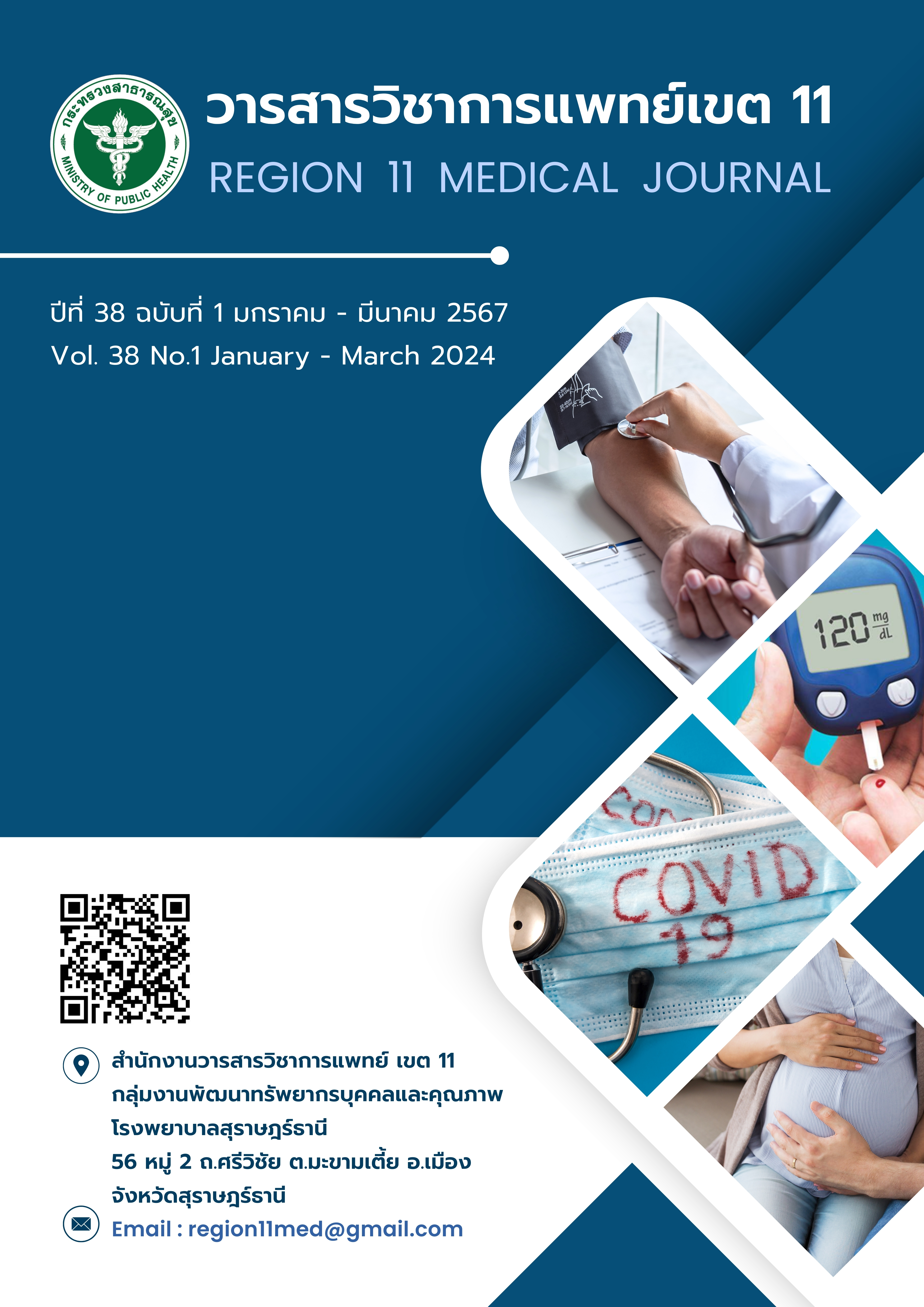Effectiveness of caring for type 2 diabetic patients to diabetes remission with intensive lifestyle modification, Suratthani Province
Keywords:
Type 2 diabetes, Intensive lifestyle modification, Diabetes remissioAbstract
Background: Currently, there is treatment for patients with type 2 diabetes to enter a phase of diabetes remission, called diabetes remission, with the aim of being able to control blood sugar to a level below the diabetes diagnosis criteria without using medication to control it. Reduce sugar levels This will improve the patient's quality of life and reduce the chance of complications.
Objectives: To study the effectiveness of caring for type 2 diabetic patients (body mass index, waist circumference, and Hemoglobin A1C: HbA1C), ability to control blood sugar, reducing medication and stopping medication with intensive lifestyle modification and satisfaction with medical treatment with intensive lifestyle modification.
Method: This research was a quasi-experimental research. The study samples were type 2 diabetic patients, aged 18 years and over, and came to treatment at Ban Na San Hospital, Kanchanadit Hospital, Ban Ta Khun Hospital, Ban Na Derm Hospital and Chaiburi Hospital (40 people each), blood sugar level before the study (HbA1c) of 7 mg% or more, amount 200 people, which were divided into experimental group and comparison group, 100 people per group. Research tools were guidelines of medical care for diabetic patients with intensive lifestyle modification and traditional lifestyle modification, health status record form, satisfaction questionnaire with intensive lifestyle modification, and health assessment tools. Data was analyzed by descriptive statistic, Chi-square test, Independent t-test and Paired sample t-test.
Results: The results after intensive lifestyle modification found that diabetic patients had decrease in body mass index, waist circumference, and HbA1c after the 3 months and 6 months study by statistical significant (p-value < 0.001), and had decrease in HbA1c after 3 months and 6 months of study more than the comparison group, decrease in body mass index, waist circumference after 6 months of study more than the comparison group by statistical significant (p-value < 0.01). After the 3 months study, diabetic patients were able to control their blood sugar at 39.0%, reduce their diabetes medications at 46.0%, but no one was able to stop their diabetes medications. After 6 months of study, they were able to control their blood sugar at 91.0%, reduce diabetes medication at 57.0% and stop medication at 16.0%. However, most of diabetic patients were satisfied with intensive lifestyle modification at high level, 93.0%.
Conclusion: This medical care by intensive lifestyle modification can be used to care type 2 diabetic patients, and should be extended to use in various hospitals in the future.
References
World Health Organization. Health literacy. The solid facts. European journal of Public, 2017, 24; 1880-87
International Diabetes Federation. IDF Diabetes Atlas Seventh Edition 2015. (online). Available from http://www.diabetesatlas.org/ (Retrieved August 2, 2023)
สำนักโรคไม่ติดต่อ กรมควบคุมโรค กระทรวงสาธารณสุข แผนยุทธศาสตร์การป้องกันและ ควบคุมโรคไม่ติดต่อระดับชาติ 5 ปี (พ.ศ. 2560 - 2564). กรุงเทพฯ: บริษัท อิโมชั่น อาร์ต จำกัด; 2560.
สุปรียา เสียงดัง. พฤติกรรมการดูแลสุขภาพตนเองของผู้ป่วยโรคเบาหวานที่ควบคุมระดับน้ำตาลในเลือดไม่ได้. วารสารเครือข่ายวิทยาลัยพยาบาลและการสาธารณสุขภาคใต้. 2560, 4(1); 191-204
American Diabetes Association [ADA]. Standards of medical care for patients with diabetes mellitus. Diabetes care. 2017, 30; S4-40.
สุปวีณ์ ธนอัศวนนท์, เอกชัย คำลือ, ธาราทิพย์ อุทัศน์, พร้อมพันธ์ คุ้มเนตร และวัชรี ผลมาก. เหตุผลการผิดนัดของผู้ป่วยเบาหวาน คลินิกเบาหวาน. วารสารโรงพยาบาลแพร่. 2554, 19(2); 85-95.
ปานทิพย์ รัตนศิลป์กัลชาญ กิตติพัฒน์ โสภิตธรรมคุณ. อันตรายจากเบาหวาน. วารสารวิทยเทคโนหัวเฉียวเฉลิมพระเกียรติ. 2559, 2(2); 1-9.
ราตรี ทองคำ. ประสิทธิผลของการส่งเสริมความรอบรู้ด้านสุขภาพต่อพฤติกรรมการดูแลตนเอง ในผู้ป่วยเบาหวานชนิดที่ 2 จังหวัดลพบุรี. วารสารโรงพยาบาลสิงห์บุรี. 2565, 30(3): 86-99.
Hfocus.org เจาะลึกระบบสุขภาพ. สมาคมโรคเบาหวานอบรม “ทางเลือกใหม่รักษาเบาหวานชนิด 2” เน้นผู้ป่วยเป็นศูนย์กลาง (ออนไลน์). แหล่งที่มา https://www.hfocus.org/print/18016 (สืบค้นเมื่อ 20 มกราคม 2566)
สำนักงานสาธารณสุขจังหวัดสุราษฎร์ธานี. รายงานสถานการณ์ผู้ป่วยโรคเบาหวานจังหวัดสุราษฎร์ธานี. สุราษฎร์ธานี: สำนักงานสาธารณสุขจังหวัดสุราษฎร์ธานี. 2566.
ราชวิทยาลัยแพทย์เวชศาสตร์ครอบครัวแห่งประเทศไทย. แนวทางการดูแลผู้ป่วยเบาหวานชนิดที่ 2 ให้เข้าสู่โรคเบาหวานระยะสงบด้วยการปรับเปลี่ยนพฤติกรรมอย่างเข้มงวด สําหรับบุคลากรทางการแพทย์และสาธารณสุข. กรุงเทพฯ: ราชวิทยาลัยแพทยเวชศาสตรครอบครัวแห่งประเทศไทย; 2565.
จรณิต แก้วกังวาล และประตาป สิงหศิวานนท์. ขนาดกลุ่มตัวอย่างในการวิจัยทางคลินิก. (ออนไลน์). แหล่งที่มา https://rdo.psu.ac.th/ Research Standards/animal/assets/document/Sample Sizes.pdf (สืบค้นเมื่อ 20 มกราคม 2566)
ศุภมิตร ปาณธูป. การพัฒนาระบบการดูแลผู้ป่วยโรคเบาหวานที่ผิดนัด. วิจัยและพัฒนาระบบสุขภาพ, 2562, 12(3): 23-34.
World Health Assembly (WHA). Strengthening integrated, people-centred health services. WHA. 2016, 69(24): 90-95.
Rice, R. Telecaring in home care: Making a telephone visit. Geriatric Nursing. 2010, 21(1): 56-57.
Kinsella, A. Telehealth and home care nursing. Home Healthcare Nurse. 2000, 15(11), 796-797.
สำนักบริหารยุทธศาสตร์สุขภาพดีวิถีไทย. รายงานฉบับสมบูรณ์ ผลการดำเนินงานขับเคลื่อนนโยบายสุขภาพดีวิถีใหม่ วิถีธรรม วิถีไทย วิถีเศรษฐกิจพอเพียง. นนทบุรี: สำนักบริหารยุทธศาสตร์สุขภาพดีวิถีไทย สำนักงานปลัดกระทรวงสาธารณสุข; 2566.
พวงเพชร เหล่าประสิทธิ์. การพัฒนาระบบการดูแลผู้ป่วยโรคเบาหวานที่ควบคุมระดับน้ำตาลในเลือดไม่ได้ ของโรงพยาบาลพุนพินและโรงพยาบาลส่งเสริมสุขภาพระดับตำบลเครือข่าย. วารสารวิชาการแพทย์เขต 11. 2565, 37(1): 29-45.
มยุรี เที่ยงสกุล. การพัฒนารูปแบบการดูแลผู้ป่วยโรคเบาหวาน โรงพยาบาลสมเด็จพระพุทธเลิศหล้า. วารสารวิชาการสาธารณสุข. 2561, 28(4): 696-710.
อนุชา วรหาญ. การพัฒนารูปแบบการดูแลตนเองของผู้ป่วยโรคเบาหวาน โรงพยาบาลเลาขวัญ. วารสารศูนย์อนามัยที่ 9. 2560, 12(27): 5-22.
Downloads
Published
How to Cite
Issue
Section
License
Copyright (c) 2024 Region11Medical Journal

This work is licensed under a Creative Commons Attribution-NonCommercial-NoDerivatives 4.0 International License.






